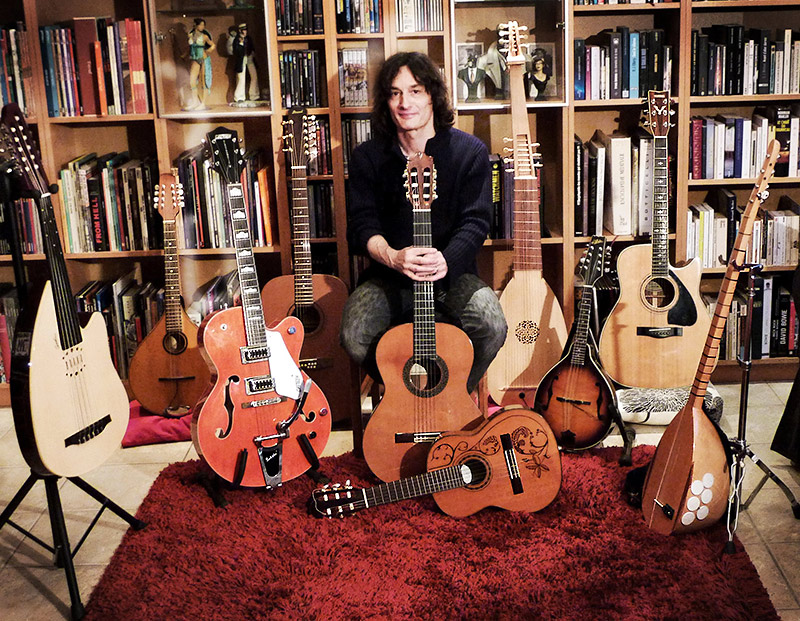Guitar speak with Jean-Luc Payssan

I never considered myself as brilliant guitarist really, but my sincere love of the instrument forced me to explore many of his different forms within Minimum Vital or Vital Duo.
As influences, I have a huge respect for great progressive guitarists of the seventies such as Steve Hackett, Steve Howe or Mike Oldfield, but I also have an affinity for acoustic classical guitar. In my way of playing, I’ve always been more interested in melody and sound than virtuosity.
That’s why I’m sure I would have been a very bad jazz guitarist or studio guitarist! Instead, I tried to build over the years a personal style, made of modal chords, Celtic and early music influences. I have a personal musical recipe that includes, among other things, love for forth and fifth intervals, the using of “open” chords and the trend of “reversing” the bass of them, witch gives them a special colour.
If the electric guitar was my main instrument from the beginning, I became more and more interested in acoustic guitars in the last few years, especially with typical Middle Eastern instruments such as the Arabian oud or the Turkish saz, witch gives, I hope, a little touch of “world music” in our progressive rock !
The Electrics
A six-string master someday said that a good guitarist must hold a Gibson guitar on one hand and a Fender guitar on another one.
Aficionados will recognize here the two major families of the electric guitar : Humbucker pickups guitars on one side, single-coil pickups guitars on the other side.
Although I agree that a good guitarist should play both Gibson and Fender, I’ve always played guitars with Humbucker pickups.
The fact is I really love that kind of sound, with warm overdrive and long sustain.
Now I’m searching for more acid, crunchy sounds. Considering the possibility of buying a Fender first, I renounced because of the neck (familiar to the classical guitar, I dislike thin necks and have a preference for large ones). That’s the reason why I recently moved to… Gretch, (and not to Fender)!
Steel strings Acoustic Guitars
When someone talks about acoustic steel guitar, one usually thinks to the folk guitar, queen of the finger-picking style, arpeggios by the fire and rhythmic companion for contemporary popular music.
But just from the Middle Ages, and especially during the 16th century you could find distant steel guitar ancestors. Very early, musicians tried to played some of those instruments in a fast rhythm style, known in those days as “battling guitar style” (in France), or “rasgueando style” (in Spain).
That’s the reason why guitar makers looked to increase the sound volume by setting them with steel strings, preferably to gut strings.
That was the origin of the cittern, the mandola, the bouzouki and many other distant guitar cousins ideally suited for band playing (that Englismen called brocken consort), and those kind of instruments surely had a great part in the birth of our modern folk guitar.
A good acoustic steel guitar should have a perfect tuning, a warm and clear sound, with enough bass and medium. You can eventually increase the harmonics by doubling the strings (octave and unison). You will find here 6 and 12 strings acoustic guitars, traditional instruments (cittern and mandola), exotic ones (Turkish saz) and some more widely known as the mandolin, most of them set with doubled strings.
Nylon string Acoustic Guitars
Nylon strings (gut strings) are ideal for the classical guitar or early instruments as the lute. This type of strings provides a warmer, soft sound, but also weaker than acoustic steel guitars.
This is of course because classical guitar and lute are made for soloist, polyphonic playing. Through the years I’ve managed to get some of those guitars amplified, so I could play them on stage, with great pleasure.